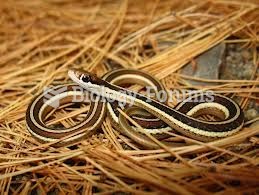(1) Because hikers, campers, and others who love the outdoors are likely to encounter a snake, they need to know the main differences between venomous snakes and non-venomous snakes. (2) Venomous snakes and non-venomous snakes differ in several ways. (3) Venomous snakes such as copperheads and rattlesnakes usually have triangle-shaped heads instead of the elongated oval-shaped heads of non-venomous snakes. (5) The eyes of venomous snakes usually have elliptical-shaped pupils instead of the rounded pupils that non-venomous snakes have. (6) Venomous snakes also have fangs, which non-venomous snakes do not have. (7) A snakebite made by a venomous snake will consist of two close-set puncture marks. (8) In contrast, a non-venomous snake's bite mark will look ragged. (9) If the snake is swimming in the water, a venomous snake such as a water moccasin will swim with its entire body visible on the water's surface. (10) However, a non-venomous snake, such as a harmless water snake, will swim with only its head above water.
Which of the following is a transitional expression used in the paragraph to indicate comparison or contrast?
A) Because
B) However
C) If
Question 2
(1) Because hikers, campers, and others who love the outdoors are likely to encounter a snake, they need to know the main differences between venomous snakes and non-venomous snakes. (2) Venomous snakes and non-venomous snakes differ in several ways. (3) Venomous snakes such as copperheads and rattlesnakes usually have triangle-shaped heads instead of the elongated oval-shaped heads of non-venomous snakes. (5) The eyes of venomous snakes usually have elliptical-shaped pupils instead of the rounded pupils that non-venomous snakes have. (6) Venomous snakes also have fangs, which non-venomous snakes do not have. (7) A snakebite made by a venomous snake will consist of two close-set puncture marks. (8) In contrast, a non-venomous snake's bite mark will look ragged. (9) If the snake is swimming in the water, a venomous snake such as a water moccasin will swim with its entire body visible on the water's surface. (10) However, a non-venomous snake, such as a harmless water snake, will swim with only its head above water.
Does this paragraph compare, contrast, or both?
A) compares only
B) contrasts only
C) compares and contrasts






